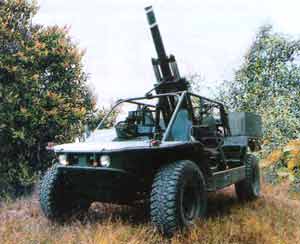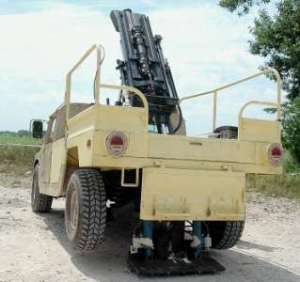| Designation: | SRAMS |
 |
|---|---|---|
| Manufacturer: | Singapore Technologies Kinetics Ltd - STK | |
| Product type: | Armoured Vehicles | |
| Name: | Self-propelled mortar |
The 120 mm smoothbore Super Rapid Advanced Mortar System (SRAMS) was developed as a private venture by Singapore Technologies Kinetics (STK). It was first revealed in late 2001 and development was completed late in 2006.
To allow it to be installed on lighter platforms it incorporates an advanced recoil system that has reduced the peak recoil to 10 tonnes when firing a 120 mm standard mortar bomb with maximum charge 9.
When firing a 120 mm standard extended-range (ER) mortar bomb with maximum charge 8, peak recoil is below 18 tonnes. According to STK, this feature allows SRAMS to be installed on a much wider range of tracked and wheeled vehicles such as the AM General High Mobility Multi-purpose Wheeled Vehicle (HMMWV).
According to STK, this light system weight allows for helicopter transportation into operations traditionally inaccessible to normal armoured personnel carrier (APC) mounted 120 mm mortars.
Development of SRAMS is continuing at the system level as different potential customers have different operational requirements. It is understood that three examples of SRAMS have been built, one prototype and two pre-production systems.
The 120 mm SRAMS also forms part of the AGRAB (Scorpion) 120 mm Mobile Mortar System (MMS) developed from early 2006 by the International Golden Group of the United Arab Emirates.
The first prototype AGRAB 120 mm MMS was completed in mid-2006 and in February 2007 the United Arab Emirates awarded the International Golden Group a contract worth SGD390 million covering the supply of 48 production AGRAB 120 mm MMS systems plus spare parts and logistics support.
Integration of production systems will take place in the United Arab Emirates and it is expected that first production systems will be delivered in the second half of 2008. Full details of the AGRAM 120 mm MMS are provided in a separate entry.
It is possible that the baseline 120 mm SRAMS is already in quantity production for the Singapore Armed Forces.
According to STK, SRAMS can be customised at a high rate of fire of up to 18 rounds per minute. This is achieved due to installation of a semi-automatic loading device that takes the 120 mm projectile from the lower part of the mortar up to the muzzle where it is automatically loaded.
On conventional 120 mm mortars, the mortar bomb normally takes several seconds to reach the bottom of the tube, as the trapped air has to escape from the small gap between the tube and the mortar bomb as it slides down the tube.
On SRAMS, a special breech valve has been incorporated into the bottom of the barrel. As the bomb travels down, the trapped air is released. When the bomb reaches the lower part it closes the valve and automatically fires.
The forged-steel smoothbore barrel is 1.8 m long and is fitted with a unique blast diffuser to enhance user safety. This allows a significant amount of high-pressure gas to escape through intermediate chambers of the diffuser before the mortar bomb leaves the barrel. This reduces blast overpressure by a considerable amount.
When carrying out sustained-fire missions, mortars can become very hot and there is always the danger of a cook-off. The in-bore barrel-cooling system of SRAMS allows high-pressure air and water mist to be injected through the breech valves. This cools the barrel with the actual cooling cycle being synchronised with the firing cycle to achieve effective cooling.
The mortar system has powered elevation limits from +40 to +80°. The weapon is laid onto the target using a joystick. Elevation is electro-hydraulic and traverse electric. Traverse is 45° left and right and the mortar is normally fired to the front of the vehicle.
Due to the installation of a navigation and positioning system based on a Ring Laser Gyro (RLG) and an Automatic Fire-Control System (AFCS), SRAMS can rapidly come into and be taken out of action. The AFCS includes a flat panel display. Future growth potential could include a Global Positioning System (GPS), which will enable a 'shoot and scoot' capability. This would increase the survivability of the platform to counterbattery fire.
STK has tested and can provide data to show that the first 120 mm mortar bombs can be fired within 60 seconds of the vehicle coming to a halt, also helping to increase its survivability against counterbattery fire. Target accuracy is increased due to the installation of the navigation and positioning system and the AFCS.
Maximum range of the SRAMS depends of the type of 120 mm mortar bomb, barrel length and the charge combination. Firing a non-assisted projectile a maximum range of 9 km can be achieved, which can be increased to about 13 km with an extended-range projectile.
According to STK, SRAMS offers the user three advanced features, which are claimed to be the world's lowest recoil force, a breech valve mechanism and an in-bore cooling system that enables the highest rate of fire and high soldier safety enabled by the blast diffuser. These three mechanisms are patent pending.
A Bronco ATTC would be able to carry about 50 × 120 mm mortar bombs for the SRAMS system, with a crew of three required to operate the system.
In addition to being installed in the Bronco ATTC, SRAMS could also be installed in the STK AV81 Terrex (8×8) APC, which remains at the prototype stage.
In February 2005 SRAMS was shown at the IDEX 2005 defence equipment exhibition integrated into the rear of an AM General HMMWV chassis. For this application the HMMWV chassis has been modified and a larger hydraulic stabiliser blade has been mounted under the rear that is lowered to the ground by remote control before firing commences. When the stabiliser blade is lowered to the ground, the rear wheels of the HMMWV are raised clear of the ground so that the rear suspension is not over-stressed. This provides a more stable firing platform.
It is envisioned that production versions would carry about 12 rounds of 120 mm ammunition, with another HMMWV carrying additional ammunition. The HMMWV is used by many countries in the Middle East for a wide range of roles and missions.
The 120 mm SRAMS has been developed with such a low recoil force that enables the mounting of the mortar onto very light platforms such as the Spider Light Strike Vehicle (LSV) that was shown for the first time in 2006.
In this configuration the 120 mm SRAMS can be deployed by small units operating independently in dismounted or in heliborne operations.
The latest Spider version of 120 mm SRAMS is seen by the company as a major step in improving the mobility of the system with particular emphasis on its use by rapid deployment type forces.
To provide a more stable firing platform two stabiliser options are under consideration, first a suspension lock out system and second a stabiliser that is lowered to the ground under the chassis.
Given the very high mobility of the Spider and its high rate of fire, it will be able to come into action, engage the target and move to another fire position before the system can be detected and engaged by counter battery fire.
Each 120 mm SRAMS firing platform can be designed to carry a quantity of ready use ammunition with another platform carrying additional ammunition.
It has also been revealed that STK have completed development of a new 120 mm Dual Purpose Improved Conventional Munition (DP ICM) mortar bomb designated the P138. This is already in quantity production and is now being offered on the export market.
This 120 mm mortar bomb, fitted with a Junghans DM93 Mod 505.54 mechanical time fuze, carries a total of 25 dual-purpose anti-personnel and anti-armour bomblets each of which will penetrate around 75 mm of rolled homogenous armour (RHA). This is sufficient to penetrate the top armour of almost all armoured fighting vehicles currently deployed.
This cargo bomb weighs 15.7 kg and is 916 mm long. Maximum range, when fired from a standard 120 mm mortar, is claimed to be 6,600 m with a 120 mm light mortar achieving a maximum range of 6,350 m. Minimum range in both cases is 980 m.
|
||||||||||||||||||
|
||||||||||||
 |
 |
 |
 |
 |
 |
 |